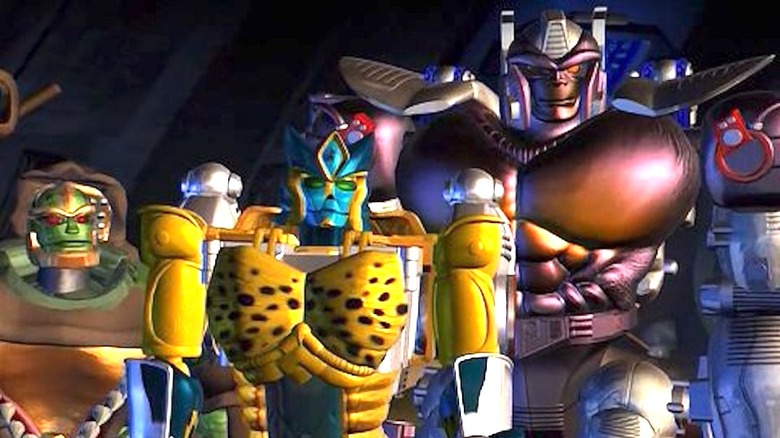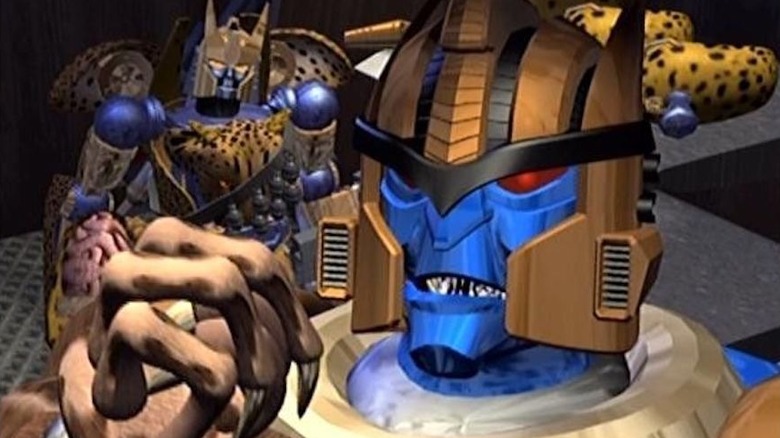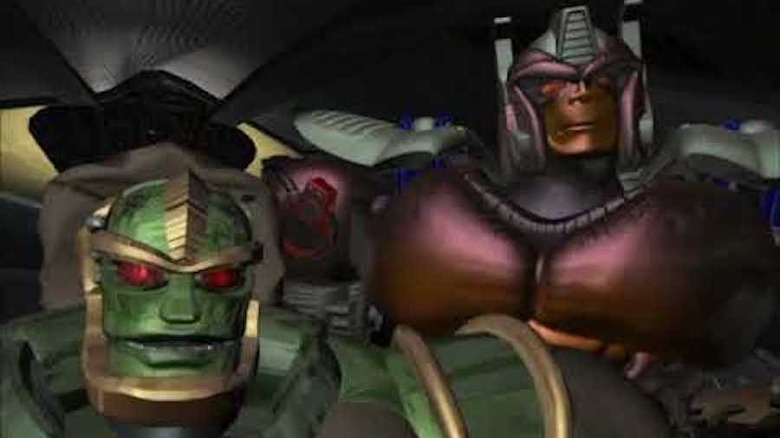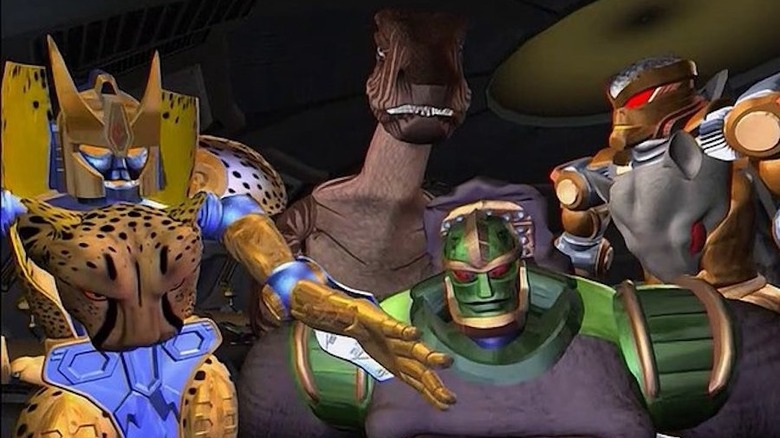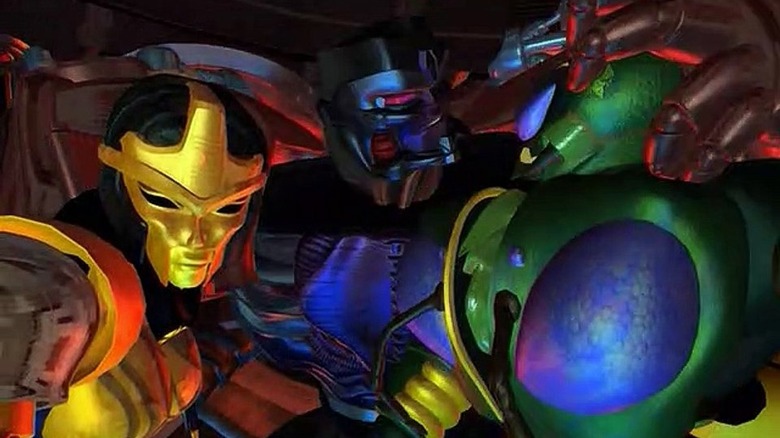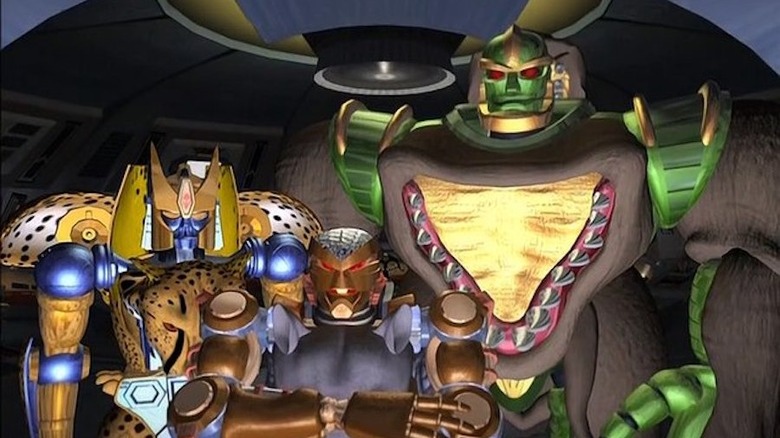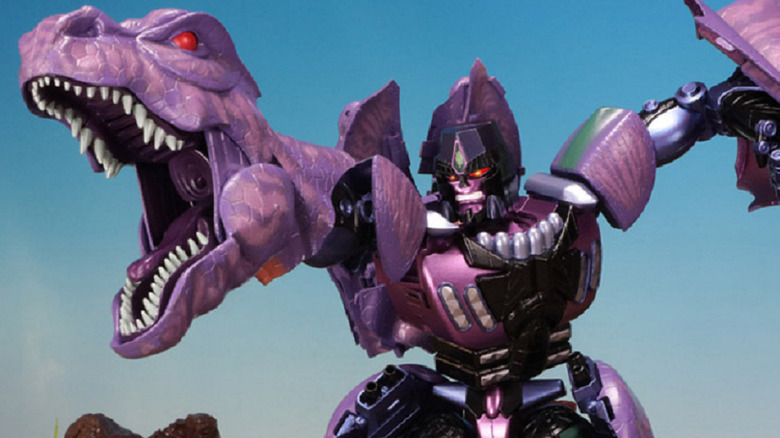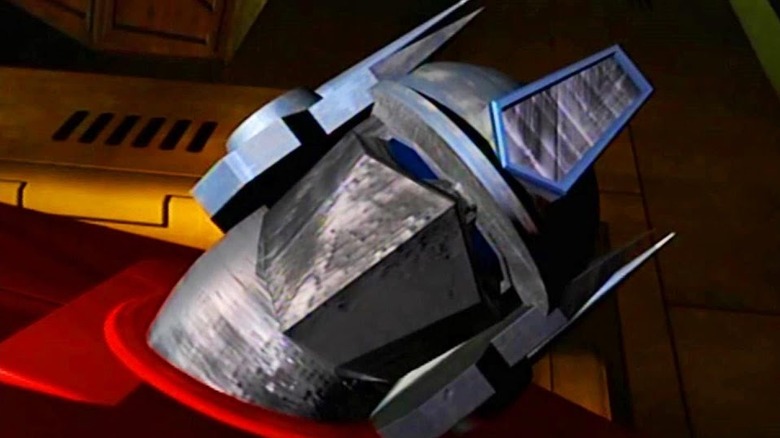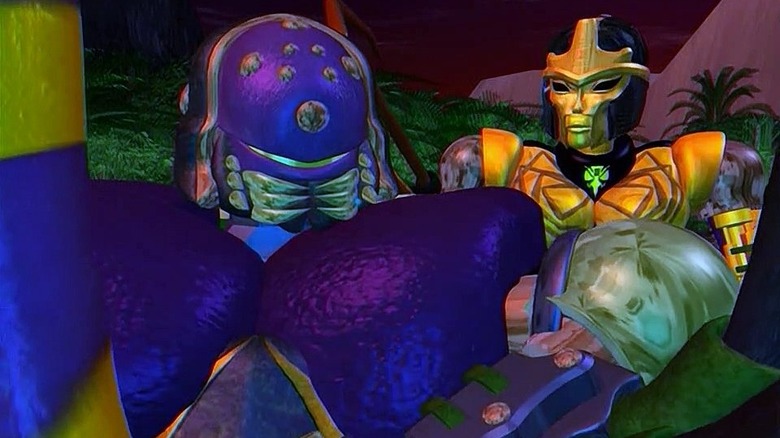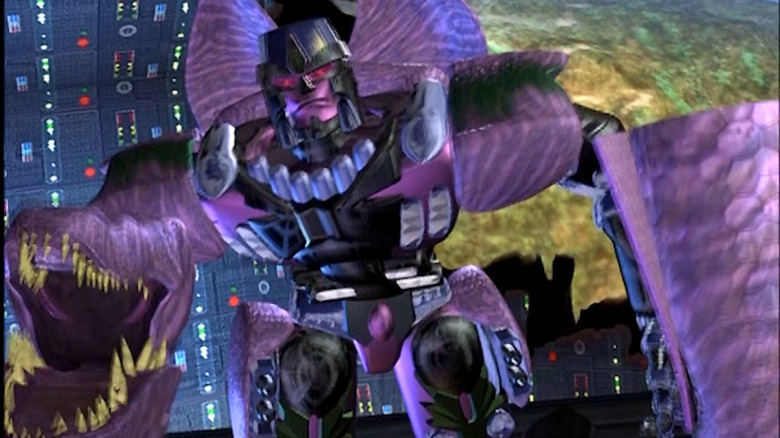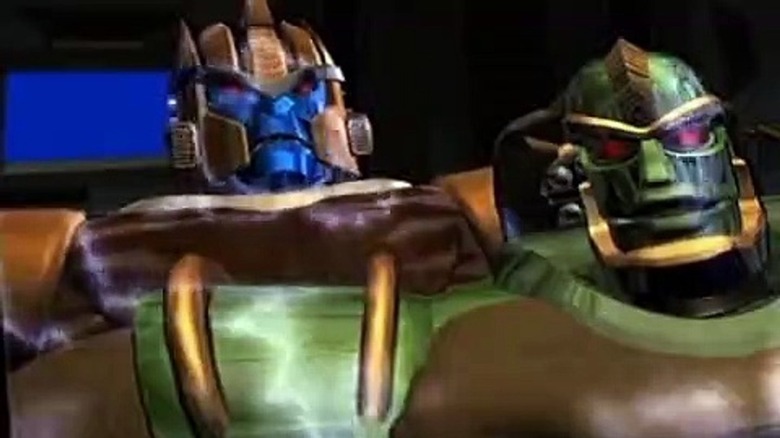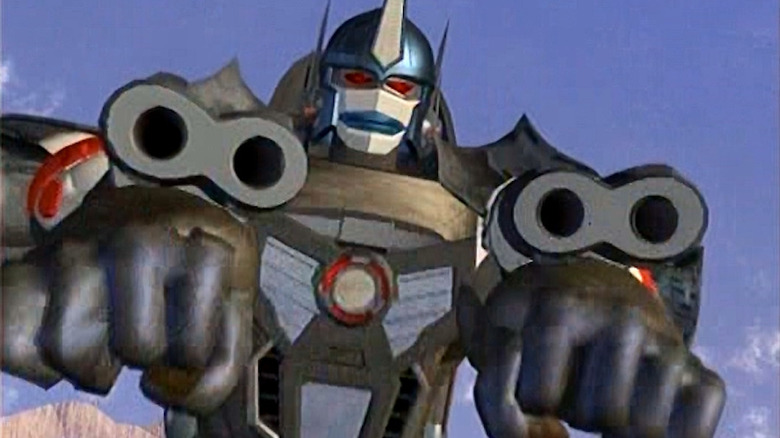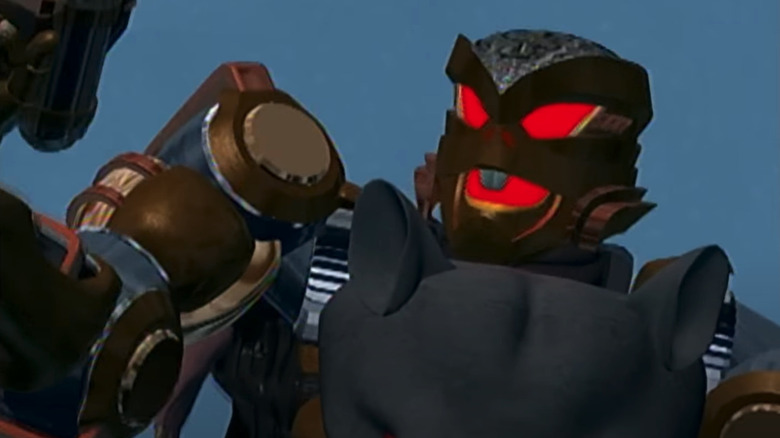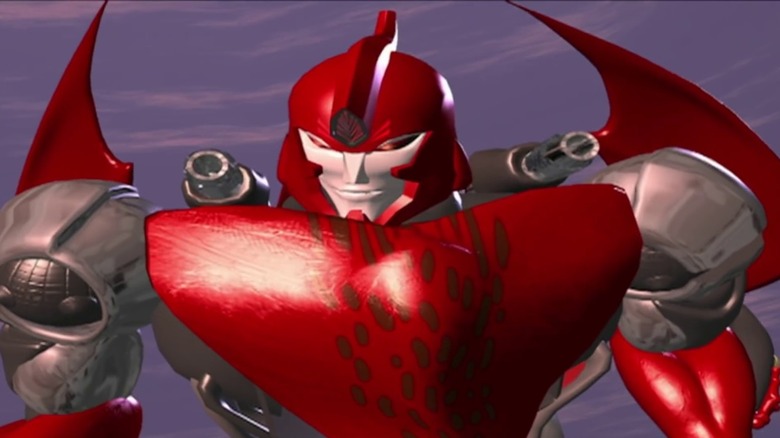The Untold Truth Of Beast Wars: Transformers
The '90s saw a sea change in children's television with modern, sophisticated shows like "Batman: The Animated Series" and "Gargoyles" that broke the mold of what a kids' cartoon could be. With more serious stories, complex characters, and jaw-dropping animation, these shows reshaped Saturday mornings and weekday afternoons. But one show that often gets overlooked for its impact on the genre is "Beast Wars: Transformers."
"Beast Wars" arrived nearly a decade after the landmark "Transformers" series from the 1980s, and few probably imagined the legacy it would achieve, considering the long shadow of its influential predecessor. Completely retooling the concept, "Beast Wars" ditches the cars and trucks and takes the Transformers to a primitive world where they crash land and take on animal forms. Instead of Autobots and Decepticons, it's Maximals and Primals engaged in an endless war for power.
Using state-of-the-art computer animation and intricately told, heartfelt tales populated by multifaceted characters, "Beast Wars" set itself apart from its contemporaries. Still overlooked today, it might be one of the most under-appreciated entries in the franchise. So, hang on to your energon, because we're exploring the untold truth of "Beast Wars: Transformers."
Beast Wars: Transformers was one of the first fully CG animated series
Computer generated animation wasn't exactly new in 1996 — it had been in kids' shows like "Captain Power and the Soldiers of the Future" as early as 1987, and even in "Transformers" episodes re-edited and repackaged as "Generation Two" in 1993. But few shows had gone to the lengths of producing their entire programs in full CG animation; instead, it was more common to see computer graphics in short bursts, either as truncated segments or to augment specific elements.
All that changed in 1994 when Mainframe Entertainment debuted "ReBoot," a series set inside the world of a computer. The company behind "ReBoot," Mainframe Entertainment (later renamed Mainframe Studios), next set its sights on "Transformers." Beginning in 1996 — just a year after the landmark Pixar film "Toy Story" — "Beast Wars: Transformers" became the second show ever to be completely computer generated.
According to series creator Larry DiTillio, who passed away in 2019, the studio believed that the reason "ReBoot" struggled after its first two seasons is that it wasn't very good. To combat this, they focused on getting great writers for "Beast Wars" to make it not just astonishing visually, but story-wise, too.
It broke new ground for CGI
When "Beast Wars" first aired, CG animation was still in its relative infancy, and few TV shows or movies dared use it as much as "Beast Wars." During its three years on the air, however, leaps in CGI technology took place, and while many such advancements were led by the likes of Pixar, Mainframe and "Beast Wars" made their own contributions.
Interviewed for the show's DVD, writer and director Bob Forward talked about the emerging technology and how they pushed the medium forward. "The neat thing about CG is it's always getting better, and so everything that you're doing, every time you go into work, it was exciting, because you'd be saying to yourself, 'We're going to do things today that have never been seen before,'" he said proudly. "Every day you were breaking new ground. Every day somebody would go, 'Look what I figured out!'"
Writer Larry DiTillio echoed Forward's sentiment. "There's a lot of stuff you have to watch out for in CGI," DiTillio explained." There's things they say, 'Oh, now we can really do anything' and the truth is no, you can't. There are things you can't do in CGI ... at that time, it was hard to do things like skipping a stone across the water ... fog, mist." But during the course of production, the animators continued pushing the boundaries of what was possible with advancements in CG animation. "They managed to do almost everything they told us not to do by the end of the show," DiTillio recalled.
Beast Wars: Transformers almost didn't get a second season
In hindsight, one might have expected "Beast Wars: Transformers" to have been an instant hit — by 1996, the original "Transformers" series was a pop culture icon with a diehard fan following. But as the creators of "Beast Wars" have often said, their show almost didn't get a second season at all.
In 1997, fresh off the first year of stories, writer Bob Forward was interviewed by an internet fan forum and asked about whether it would be back for Season 2. At the time, he didn't sound too optimistic. "Second season is still iffy," Forward cautioned. "Hasbro wants one, but they want it for less money since that is standard animation procedure. Mainframe is willing to do it but they want more money because CGI is expensive."
That same year in a different interview, Forward talked about the challenges faced by Season 2. "The show's not cheap. The first 26 [episodes] cost, I believe, $18 million," he explained. "Hasbro claims they are not getting the European financing because the toys haven't been released there. Maybe. It could also be their belief that a second season should cost less because so many characters are already created." Eventually, the two sides hashed out their differences, leading to two additional 13-episode seasons. But if they hadn't made that compromise, the series may have ended on a cliffhanger. "We are expecting to hear audible screams of frustration from fans," a pessimistic Forward declared at the time.
It wasn't what Hasbro or the fans really wanted
When development began on "Beast Wars," Hasbro knew they wanted a show where the Transformers were animals, but everything else was left open for writers like Larry DiTillio and Bob Forward to craft themselves. What they came up with was a pair of rival factions — the Maximals and the Predacons — and, at least at first, the series is entirely composed of an all-new roster of robots with no characters from the "Generation One" series at all.
As DiTillio has told it, this didn't sit well with some executives at Hasbro. "There was a guy at Hasbro, and he was like a walking 'Transformers,' encyclopedia," DiTillio said. "He really kind of wanted to make the original 'Transformers' again. Later on, we found out that the fans wanted us to make the original 'Transformers' again. They wanted to see Starscream, they wanted to see Optimus Prime. ... that was a little rift between us and the fans right from the beginning."
Not being fans of the original show, however, DiTillio and Forward forged ahead with their own story. "What we wanted to do and what hit us was, it's a science fiction show, and we want to really get deep into these characters."
Beast Wars: Transformers invented the concept of the spark
These days, the concept of a Transformer's "soul," referred to as their "spark," is integral to the franchise. In fact, it even plays a significant role in the Michael Bay feature films and is a plot device in nearly every "Transformers" series. Believe it or not, though, the concept of the spark didn't originate from the original TV series in the '80s — it's the work of writers on "Beast Wars," including Larry DiTillio. "We set up what everyone accepts today as being a major part of the 'Transformers' property," he told Inverse in 2021.
The concept gets its first mention in the appropriately titled episode "The Spark," where a stasis pod containing a yet-to-be-activated Transformer crash lands on the planet. Whichever side acquires it can imbue the new Transformer with their own faction's spark and add it to their ranks, potentially turning the tide in their never-ending battle for supremacy.
"If they just get shot up, we can bring 'em back, but if the spark goes out, they're dead," DiTillio explained. "We really ran with that idea in the first season and most of the second season." Being given the chance to create all-new mythology was exactly what appealed to the writing team. "It was all new ground for us, and it was all new ground for the 'Transformers' fans."
Fans on the internet helped shape the story
In September of 1996, viewers got their first look at "Beast Wars." But 1996 was also a watershed year in the history of the internet as activity on the World Wide Web exploded. As a result, fans of various TV shows began congregating in communities online, and when "Beast Wars" began airing, the writers found themselves engaging with them in a surprisingly collaborative way.
"That was, oddly enough, suggested by Hasbro themselves," said writer Bob Forward. "They actually monitored [internet forums] sometimes to see how they were doing. ... We were still very new to the Internet, we were using AOL, but we started being on there a lot." What they found there was a passionate group of fans whose discussion of the show and guesses about where the story might be headed helped spark ideas among the staff. "We were like, huh, I didn't think of that ... so we started looking things up and it was like, 'That could work!'"
After the monitoring of fan activity online proved fruitful, Forward and others became more active in engaging with the audience. Eventually, one knowledgeable and amiable fan named Benson Yee began working with Forward and his writing staff directly, offering ideas when they needed to dip into "Transformers" continuity. As Forward tells it, Yee's advice led to the appearance of Ravage, and as a thanks, Yee showed up in the episode's closing credits.
Introducing G1 Transformers was a controversial decision
Ravage wasn't the only Generation One (G1) Transformer to show up on "Beast Wars," of course, and thanks to some input by the fans, the Maximals and Predacons discover the Ark from the original "Transformers" series buried beneath the Earth, and we get glimpses of the original Autobots, including Optimus Prime. But strange as it may seem, especially considering some at Hasbro had initially wanted those classic characters to appear in the series, the decision to include the likes of Optimus Prime and Ravage was a controversial one behind the scenes.
"Hasbro didn't like it, which was really weird," said Larry DiTillio during an appearance on the podcast All Things Transformers in 2010. "They said, 'We're not trying to sell old G1 toys.'" Yet, despite the company's reluctance, DiTillio and his staff pushed to get it on screen. Thankfully, the team at Mainframe had at least one ally within Hasbro who loved the concept and helped convince the higher-ups at the company to go along with the idea.
Eventually, the storyline didn't just see the appearance of the Ark and Optimus Prime, but an appearance from the original Starscream, much to the delight of longtime fans.
Beast Wars: Transformers wasn't made just for kids
It goes without saying that "Beast Wars: Transformers" was a children's animated series, but it was also one of many shows in the early to mid '90s that garnered an older, sometimes even adult audience, and that was by design. Because the writers behind the series weren't aiming to make a show for kids, but a show for families — something that parents and their kids could watch together.
"I kind of try to write shows that are family oriented, that a child could watch with their parents, and both could enjoy on different levels," said Larry DiTillio in an interview from 2000 with fan outlet Radio Free Cybertron. "I think 'Beast Wars' is probably the closest we ever got to doing that, where adults and children alike both liked it for different reasons: The kids kind of liked the toys bashing on each other, and the adults kind of liked the kind of serious plots that were going through there despite all the silliness."
The focus on stories that could appeal to all ages may have seemed odd at the time for "Transformers," but it's one reason why the show remains popular among Transformers fans more than 25 years later.
What Beast Wars: Transformers Season 4 could have been
After "Beast Wars: Transformers" ended, it was followed by two seasons of "Beast Machines," which saw a drastic overhaul of the show, bringing the battle between the Maximals and the Predacons back to their home planet of Cybertron. The switch-up allowed Hasbro to move the show to Fox and refresh all their characters — and their toys — with new looks and a new story.
But it also signaled the end of writers Larry DiTillio and Bob Forward, who exited the series when "Beast Wars" came to a close, forcing them to scrap bold plans for a possible fourth season of the show. According to DiTillio, the proposal for Season 4 would have seen the Maximals escaping Earth and heading back to Cybertron. But rather than arrive to a world controlled by a maniacal Megatron, the Maximals would have continued the Beast Wars in space. "We thought they worked better in space than they did on planet-bound," he told All Things Transformers in 2010.
Earlier, in his interview with Radio Free Cybertron, DiTillio was more specific, saying that Season 4 would have seen the Maximals "traveling from planet to planet," apparently with Megatron and the Predacons in hot pursuit, turning the series from an Earth-bound adventure into a space-based chase.
Dark Glass, the lost episode of Beast Wars: Transformers
Easily the most beloved episode of "Beast Wars," the installment "Code of Hero" includes the demise of Predacon-turned-Maximal Dinobot. The death is moving and tragic enough that it prompted heartfelt letters from adults and children, as Larry DiTillio told All Things Transformers. As most fans will remember, DinoBot is resurrected, sort of, in the episode "Feral Scream, Part I," but he almost returned more directly in an abandoned episode titled "Dark Glass."
Planned for early in Season 3, "Dark Glass" would have seen Rattrap become convinced that he can bring Dinobot back to life by infusing a new body with some of Dinobot's core consciousness. What follows is an existential battle as the new and old versions of Dinobot battle for control of his new body. For years, rumors swirled that the episode was too dark for kids, or had been ordered cut by censors, but the truth according to DiTillio is a bit simpler. "We simply didn't like the script," he told All Things Transformers.
But it all worked out, because as DiTillio told it, the episode that replaced it by the same writer wound up being "Transmutate," another fan favorite that still ranks among the show's best.
The planet in Beast Wars wasn't supposed to be Earth
When "Beast Wars" debuted, the big mystery on many viewers' minds was the planet this show takes place on. Given the animals there, including dinosaurs, cheetahs, apes, rats, and rhinos, it seems to be Earth. Yet, up in the sky are not one, but two moons, suggesting that this is an alien world. As Larry DiTillio has said, that was exactly the plan when they started the series.
"We didn't want to make it Earth," the writer told All Things Transformers. "We wanted to say, 'Well, it's an Earth-like planet, we don't really know where we are.'" Once again, however, Hasbro came down with an edict midway through the series and demanded that the planet be revealed as our own. This required some clever thinking, though, and in 2021, in his interview with Inverse, DiTillio put it bluntly, "We'll just blow up the moon." And that's exactly what they did, with the second lunar body revealed to be an alien construct.
Despite being against the idea initially, their lone supporter within Hasbro convinced them it was the right move. "He was saying, 'No this is good because it ties it in with the old show,'" DiTillio said. In the end, the decision wound up working in their favor, allowing the appearance of Starscream, Ravage, and others.
It was the first Transformers show to win an Emmy
Kids' cartoons like "G.I. Joe" and "He-Man" are often rightly thought of as little more than glorified commercials designed purely to sell toys. In a very real way, that was also the case with "Beast Wars: Transformers," too, but that doesn't mean it's without artistic merit. During its run it was handed a major Emmy award — the first for the "Transformers" franchise. While the writers of the series worked hard to ensure the stories were engaging and even thought provoking, it was the cutting-edge CG animation that earned it the honor.
Pushing the limits of what was possible in 3D animation at the time — particularly on TV — "Beast Wars" helped elevate the emerging medium of CGI, paving the way for shows like "Max Steel" and "The Adventures of Jimmy Neutron, Boy Genius." For their efforts, "Beast Wars: Transformers" took home a 1998 Daytime Emmy for outstanding achievement in animation, credited to production designer Clyde Klotz, who had previously worked on "The X-Files" and went on to work for such hits as "Fringe" and the movie "Fifty Shades of Grey."
Its legacy goes far beyond its three seasons
If you're a fan of "Beast Wars: Transformers," but only know the three seasons that aired between 1996 and 1999, you're actually missing out on one of the most underrated franchises-within-a-franchise around. Because "Beast Wars" didn't stop when the series aired the third season finale, "Nemesis: Part 2." In addition to the two seasons of "Beast Machines" that followed shortly thereafter, "Beast Wars" has more adventures in stories that more casual fans may not be aware of.
Fans in America probably didn't know it at the time, but while "Beast Wars" was still on the air, "Beast Wars II" debuted in Japan as a more traditional hand-drawn anime. It features an entirely different set of characters — with the two factions led by Lio Convoy and Galvatron — and ran for 43 episodes. Like its American counterpart, "Beast Wars II" received its own follow-up, this one called "Super Life-Form Transformers: Beast Wars Neo," which itself produced 35 additional installments.
Beyond animation, "Beast Wars" continued in comic books, with a series from IDW in the 2000s, and a new series in 2021. Two years later, the series formed the basis for the live-action "Transformers" sequel "Rise of the Beasts," directed by Steven Caple Jr. and starring Ron Perlman as Optimus Primal.
